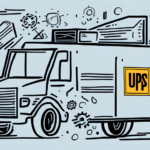The Advent of Oversized Ecommerce: A Revolution in Shopping
The rise of oversized ecommerce has brought about a transformational change in the way we shop. The ability to purchase oversized goods online, such as furniture, appliances, and machinery, has revolutionized the retail industry. In this article, we will delve into the advantages of oversized ecommerce, how it's changing the retail landscape, the role of technology in its growth, and the future of this rapidly expanding industry.
The Rise of Oversized Ecommerce: An Overview
The surge in oversized ecommerce can be attributed to the increasing demand for convenience among consumers. With ecommerce platforms offering a vast array of products and services, consumers can now easily purchase large goods from the comfort of their homes. According to a Statista report, online furniture sales in the U.S. alone are projected to reach $80 billion by 2025.
The COVID-19 pandemic has further accelerated the growth of oversized ecommerce. With lockdowns and social distancing measures in place, consumers turned to online shopping as a safer alternative to in-store purchases. This shift resulted in a significant increase in demand for oversized items such as furniture, home appliances, and exercise equipment, which are cumbersome to transport from physical stores to homes. Consequently, ecommerce companies have expanded their offerings to include oversized items and have invested heavily in logistics and delivery infrastructure to meet the growing demand.
The Advantages of Oversized Ecommerce for Consumers
Oversized ecommerce offers numerous benefits to consumers:
- Wider Selection: Consumers have access to a broader range of products, often at more competitive prices compared to brick-and-mortar stores.
- Convenience: Eliminates the need for physical store visits, saving time and effort.
- Price Comparison: Allows consumers to easily compare prices and features from different retailers, enabling informed purchasing decisions.
- Personalized Shopping Experience: Online retailers utilize data analytics to track consumer behavior and preferences, offering personalized recommendations and promotions.
With the advent of fast and reliable shipping services, the convenience factor of oversized ecommerce has only increased in recent years. According to a 2023 eMarketer report, global ecommerce sales are expected to surpass $6 trillion, with a significant portion attributed to oversized goods.
How Oversized Ecommerce is Changing the Retail Landscape
The growth of oversized ecommerce has significantly impacted the retail landscape:
- Increased Competition: Brick-and-mortar stores face stiff competition from online platforms, prompting many to rethink their business models.
- Expanded Product Range: Online retailers can stock a vast array of products without the constraints of physical space, leading to the rise of niche markets and specialty products.
- Data-Driven Strategies: Access to extensive customer data allows online retailers to optimize marketing strategies and personalize the shopping experience.
For example, companies like Wayfair have leveraged their online presence to dominate the furniture market by offering an extensive selection that physical stores cannot match.
The Role of Technology in the Growth of Oversized Ecommerce
Technology has been a cornerstone in the expansion of oversized ecommerce:
- Advanced Logistics: Innovations such as automated warehouses and last-mile delivery robots have enhanced operational efficiency and delivery speed.
- Data Analytics: Helps optimize supply chains and improve overall business efficiency by analyzing consumer behavior and forecasting demand.
- Immersive Customer Experiences: Virtual Reality (VR) and Augmented Reality (AR) allow customers to visualize products in their own spaces before making a purchase.
- AI-Powered Customer Service: Chatbots and AI-driven support systems provide quick and personalized assistance to consumers.
According to a McKinsey report, the integration of automation in warehouses can increase productivity by up to 20%, significantly reducing fulfillment times.
The Future of Oversized Ecommerce: Opportunities and Challenges
The future of oversized ecommerce is bright, filled with numerous opportunities and challenges:
Opportunities
- Personalization and Customization: Advancements in technology enable companies to offer products tailored to individual customer preferences, enhancing satisfaction and loyalty.
- Global Expansion: Companies can tap into international markets, broadening their customer base and increasing revenue streams.
Challenges
- Environmental Concerns: Addressing the impact of packaging and shipping on the environment is crucial for sustainable growth.
- Cybersecurity and Data Privacy: Ensuring the protection of consumer data is essential to maintain trust and comply with regulations.
- Intense Competition: As more players enter the oversized ecommerce space, differentiating through unique value propositions and exceptional customer service becomes vital.
To stay competitive, ecommerce companies must innovate continuously and adopt sustainable practices. According to a Forbes article, integrating sustainable practices can not only reduce environmental impact but also attract environmentally conscious consumers.
The Impact of Oversized Ecommerce on Small Businesses
Oversized ecommerce has a dual impact on small businesses:
Positive Impacts
- Increased Reach: Provides small businesses with a platform to reach a wider audience, competing with larger retailers.
- Access to Resources: Many ecommerce platforms offer tools and resources that help small businesses optimize their online presence and marketing strategies.
Negative Impacts
- Intense Competition: Competing with large ecommerce platforms that offer low prices and high convenience can be challenging.
- Reduced Personalization: Larger platforms often prioritize efficiency over personalized customer experiences, which can disadvantage small businesses relying on strong customer relationships.
To thrive, small businesses should focus on providing unique value propositions and niche offerings that differentiate them from larger competitors. Investing in personalized customer service and building a strong brand identity can also help mitigate the challenges posed by oversized ecommerce.
The Ethical Implications of Oversized Ecommerce
Oversized ecommerce brings several ethical considerations:
Environmental Impact
Ecommerce operations contribute to environmental challenges through packaging waste and carbon emissions from shipping. Companies must adopt sustainable practices, such as using recyclable materials and optimizing delivery routes to minimize their carbon footprint.
Labor Practices
Ensuring fair labor practices within supply chains is essential. Ecommerce companies should conduct regular audits and collaborate with suppliers who adhere to ethical labor standards.
Impact on Local Economies
The dominance of large ecommerce companies can negatively affect small businesses and local economies by driving them out of the market. Ecommerce giants should consider supporting local businesses through partnerships and by providing platforms that allow smaller retailers to thrive.
Addressing these ethical implications is crucial for the sustainable growth of oversized ecommerce. Consumers are increasingly valuing corporate responsibility, and companies that prioritize ethical practices are more likely to gain consumer trust and loyalty.
How to Make the Most of Oversized Ecommerce as a Consumer
Consumers can utilize several strategies to maximize the benefits of oversized ecommerce:
- Thorough Research: Investigate products extensively, read reviews, and compare prices across multiple platforms to ensure informed purchasing decisions.
- Utilize Free Shipping and Return Policies: Take advantage of offers that allow for risk-free purchases and returns.
- Support Small Businesses: Whenever possible, choose to purchase from small businesses and local retailers to support diverse market offerings.
- Leverage Technology: Use AR and VR tools provided by retailers to visualize products in your space before buying.
By adopting these practices, consumers can enhance their shopping experience, ensuring they get the best value and quality from oversized ecommerce platforms.
A Comparative Analysis: Traditional Shopping vs. Oversized Ecommerce
When comparing traditional shopping with oversized ecommerce, several key differences emerge:
| Aspect | Traditional Shopping | Oversized Ecommerce |
|---|---|---|
| Convenience | Requires visiting physical stores | Shop from anywhere at any time |
| Product Range | Limited by store space | Extensive variety without space constraints |
| Price Comparison | More time-consuming | Easy and quick comparison online |
| Personalization | Less tailored | Highly personalized recommendations |
| Immediate Gratification | Instant possession of products | Waiting period for delivery |
While traditional shopping offers the tactile experience of interacting with products before purchase, oversized ecommerce provides unparalleled convenience and a broader selection. The choice between the two depends largely on individual preferences and specific needs.
Case Studies: Success Stories in Oversized Ecommerce
Several companies have successfully navigated the oversized ecommerce space, setting benchmarks for others to follow:
- Wayfair: Specializing in furniture and home goods, Wayfair has grown rapidly by offering an extensive product range and utilizing data-driven marketing strategies.
- IKEA: While traditionally a brick-and-mortar retailer, IKEA has made significant strides in its online presence, integrating omnichannel strategies to enhance the customer experience.
- Amazon: Leveraging its vast logistics network and innovative delivery solutions, Amazon has become a dominant player in the oversized ecommerce market.
These companies emphasize the importance of customer experience, operational efficiency, and innovation in sustaining growth and maintaining a competitive edge in the oversized ecommerce industry.
How to Start an Oversized Ecommerce Business
Launching an oversized ecommerce business requires meticulous planning and strategic execution. Key considerations include:
- Sourcing and Inventory Management: Establish reliable suppliers and implement efficient inventory management systems to handle large products.
- Reliable Shipping Partners: Partner with logistics providers that specialize in handling oversized items to ensure timely and safe deliveries.
- Online Platform Development: Build a user-friendly and scalable ecommerce platform that can showcase large products effectively, possibly incorporating AR/VR features.
- Financial Investment: Prepare for significant upfront costs related to inventory, warehousing, and technology infrastructure.
- Market Research: Conduct thorough market analysis to identify demand, understand competition, and determine unique selling propositions.
Successful oversized ecommerce ventures often prioritize customer satisfaction and operational efficiency, ensuring that large products are delivered in pristine condition and that customers receive exceptional service throughout their buying journey.
Common Mistakes to Avoid When Starting an Oversized Ecommerce Business
Entering the oversized ecommerce market comes with its set of challenges. Avoiding the following common mistakes can enhance the chances of success:
- Underestimating Operational Costs: Failing to account for expenses related to warehousing, shipping, and handling can strain financial resources.
- Weak Online Presence: Inadequate investment in digital marketing and website optimization can hinder visibility and sales.
- Poor Inventory Management: Inefficient inventory tracking can lead to stockouts or overstocking, affecting customer satisfaction and profitability.
- Lack of Unique Value Proposition: Offering generic products without differentiation makes it difficult to stand out in a crowded market.
- Inadequate Market Research: Not understanding the target audience or market trends can result in mismatched product offerings and marketing strategies.
By addressing these areas proactively, startups can establish a robust foundation for their oversized ecommerce ventures.
The Role of Social Media in the Growth of Oversized Ecommerce
Social media has become an integral component of oversized ecommerce growth strategies:
- Brand Awareness: Platforms like Instagram, Facebook, and Pinterest allow ecommerce companies to showcase their products to a vast audience.
- Influencer Marketing: Collaborating with influencers can drive traffic and build trust among potential customers.
- User-Generated Content: Encouraging customers to share their purchases enhances credibility and fosters community engagement.
- Data Insights: Social media analytics provide valuable information on consumer preferences and trends, aiding in strategic decision-making.
For example, Wayfair effectively uses Instagram to display its furniture collections, inspiring customers and driving traffic to their online store through visually appealing content.
Innovations in Delivery Services to Accommodate Oversized Packages
The rise of oversized ecommerce has necessitated advancements in delivery services to handle larger and heavier packages efficiently:
- Automated Warehouses: Enhance storage and retrieval processes, reducing the time from order placement to shipment.
- Delivery Robots and Drones: Innovate last-mile delivery, making it faster and more cost-effective.
- Advanced Packaging Materials: Utilize sustainable and protective packaging to minimize waste and safeguard products during transit.
- In-Home Delivery Services: Offer services that include product assembly and placement within the consumer's home, enhancing customer satisfaction.
- Package Lockers: Provide secure and convenient pickup locations for oversized items, reducing the risk of theft and ensuring timely deliveries.
Companies like FedEx have invested in automated sorting systems to handle the increasing volume of oversized packages, significantly improving delivery times and operational efficiency.
Conclusion
Oversized ecommerce has fundamentally transformed the retail industry, offering consumers unparalleled convenience and access to a diverse range of goods and services. As the sector continues to grow, it faces significant challenges, including environmental sustainability and maintaining consumer trust. Success in this dynamic landscape will require ecommerce companies to innovate continuously, prioritize ethical practices, and deliver exceptional value propositions to their customers. By addressing these factors, oversized ecommerce can sustain its growth trajectory and further revolutionize the shopping experience.




















